Poem A (installation
view), 2005 Video installation
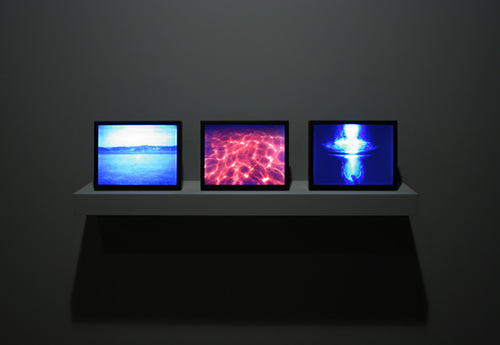
Becoming Light(installation
view), 2005 Video installation
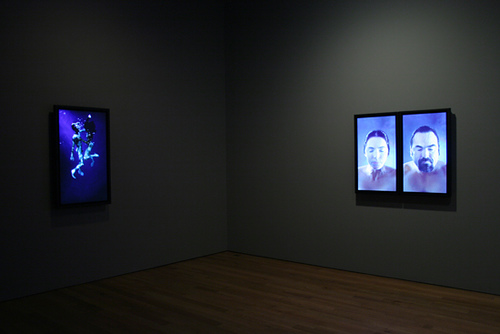
Ablutions(installation
view), 2005 Video installation
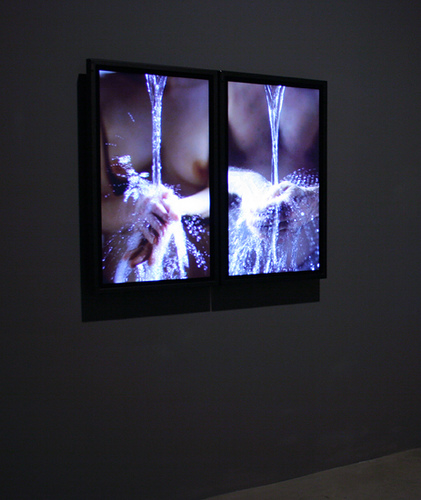
Video still
from Tristan and Isolde, 2005 Photo: Kira Perov
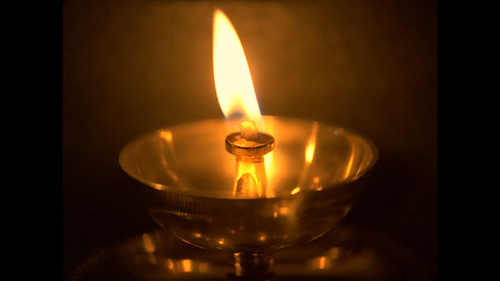
The Darker
Side of Dawn, 2005 Video installation Photo: Kira Perov
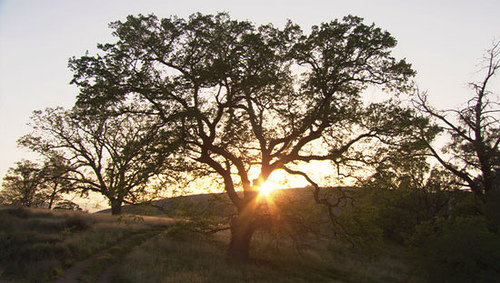
Dissolution,
2005 Video installation Photo: Kira Perov
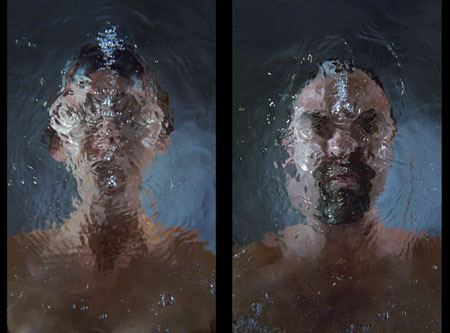
Ablutions,
2005 Video installation Photo: Kira Perov
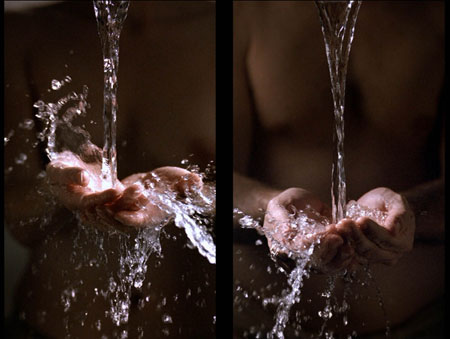
Going Forth
By Day: The Voyage (4) Image size: 90 x 160 in / 228.6 x 406.4 cm
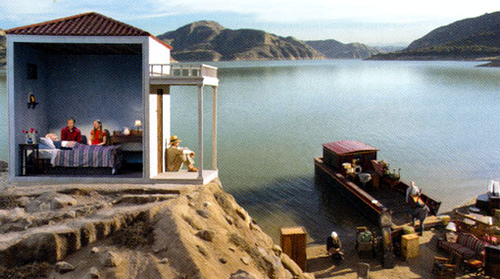
Going Forth
By Day: Fire Birth (1) Image size: 144 x 192 in / 365.8 x 487.7 cm
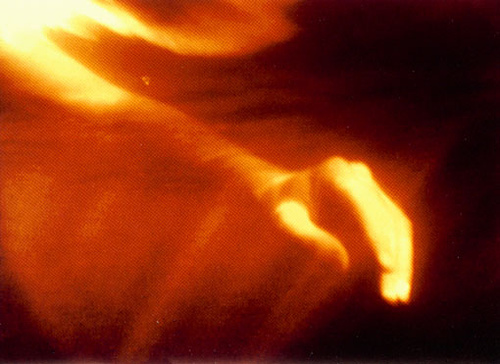
Night Journey,
2005 Video installation Photo: Kira Perov

Night Journey,
2005 Video installation Photo: Kira Perov
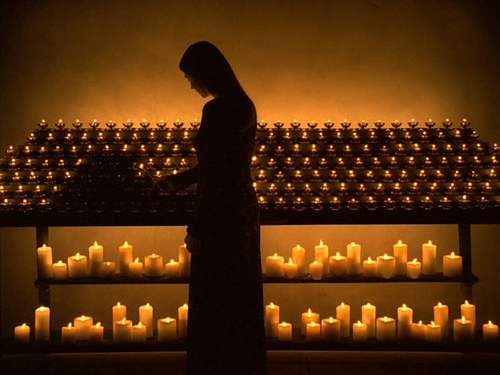
Night Journey,
2005 Video installation Photo: Kira Perov
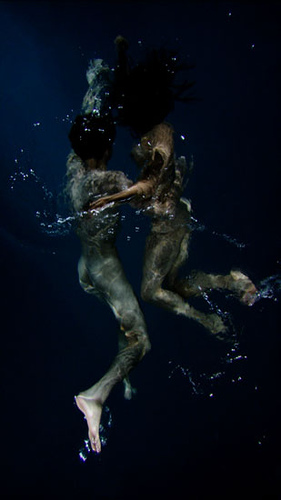
Going Forth
By Day: The Deluge (3) Image size: 144 x 192 in / 365.8 x 487.7 cm
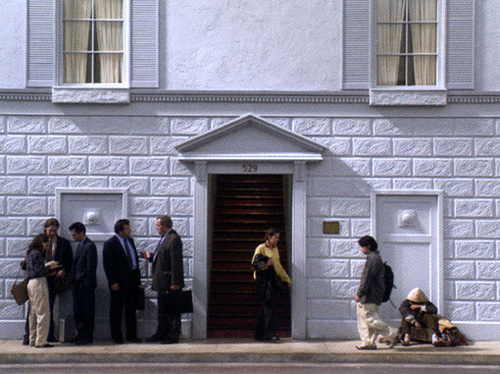
Going Forth
By Day: First Light (5) Image size: 90 x ? in / 228.6 x ? cm (width to
be determined)
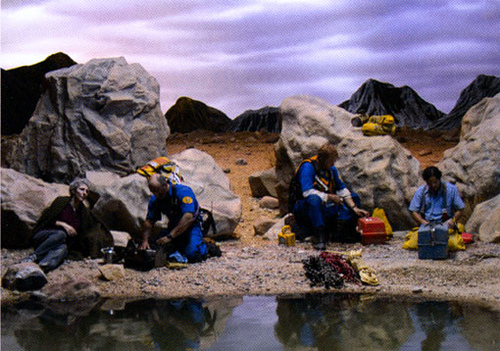
The Quintet
of Remembrance, 2000 Video installation , Color video rear projection
on large screen in darkened room, 15 1/2 minute loop 12' x 18' x 24' (room
dimensions) (365.8 x 548.6 x 731.5 cm) Edition of 3
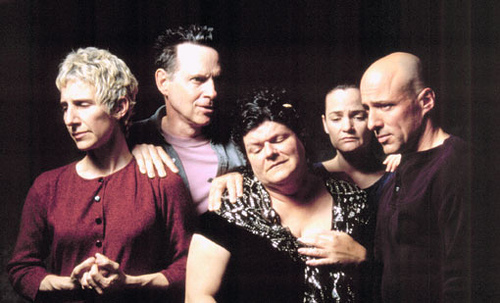
Ascension,
2000 Video/sound installation, Large color video projection on white wall
in darkened room; two channels amplified sound, 10 minute loop Edition
of 3
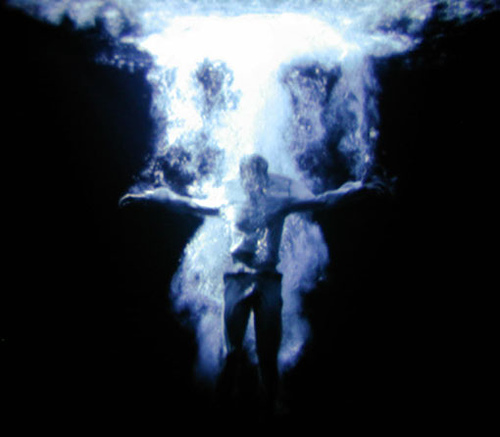
Dolorosa,
2000 Color video diptych on two freestanding vertical LCD flat panels
framed and hinged together, 11 minute loop 16 X 24 1/2 X 5 3/4 inches
Edition of 5
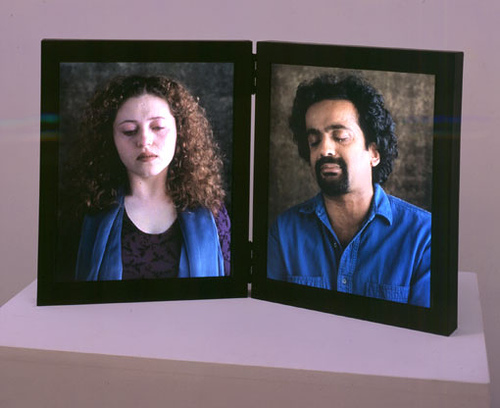
The Locked
Garden, 2000 Color video diptych on two freestanding vertical LCD flat
panels framed and hinged together, 15 minute loop 16 1/4 X 26 1/8 X 6
1/2 inches Editon of 5
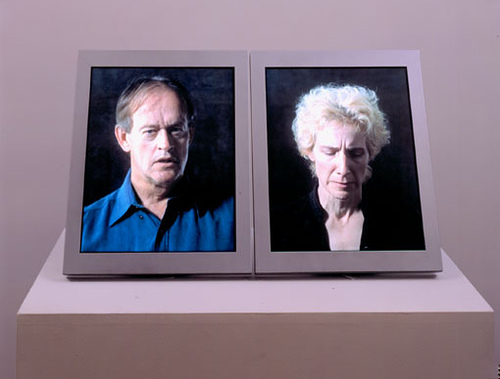
The Locked
Garden, 2000 Color video diptych on two freestanding vertical LCD flat
panels framed and hinged together, 15 minute loop 16 1/4 X 26 1/8 X 6
1/2 inches Editon of 5
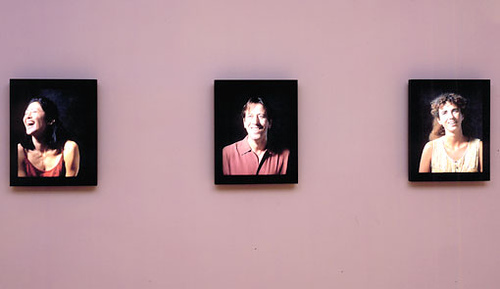
Union, 2000
two channels of color video on two plasma displays mounted side-by-side,
vertically on wall , 8 minute loop 40 1/2 X 50 X 7 inches Edition of 5
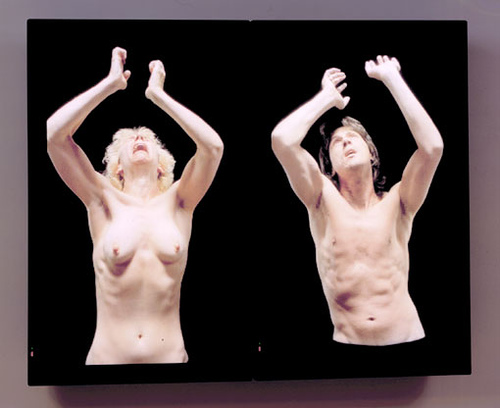
Six Heads,
2000 Color video on plasma display mounted vertically on wall 40 1/2 X
24 3/4 X 7 inches Edition of 12
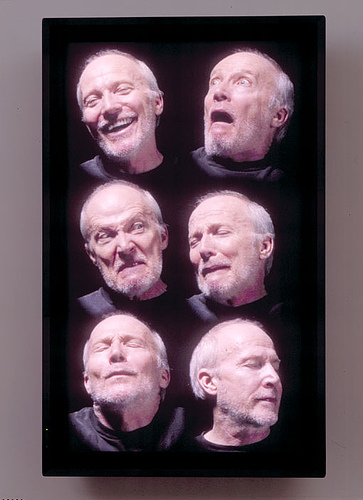
Memoria, 2000
Black-and white video projection on small cloth screen suspended in dark
room Edition of 5
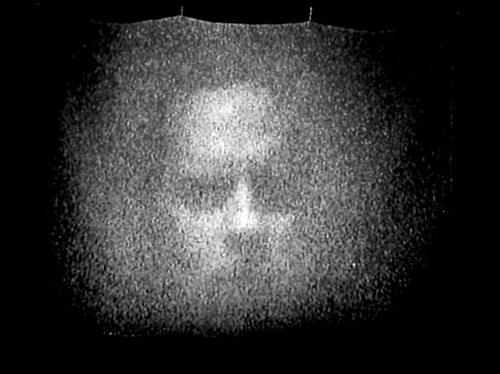
作者资料
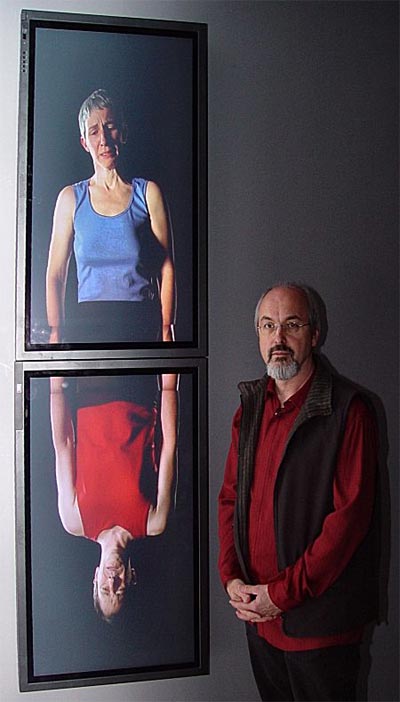
比尔·维奥拉(Bill Viola)1951年生于美国纽约,现在长滩居住。
在录像艺术的舞台上,比尔·维奥拉是一位耀眼的国际明星,他的作品使录像艺术在更大的范围内得到普及,并被越来越多的人所接受。比尔·维奥拉始终以现代录像技术和计算机为手段,继承和发扬了传统的绘画语言与色彩语言。他的作品十分注重色彩与布局结构,并经常采用几个作品为一组的投影方式,看起来就像是一个放大了的绘画作品。在他的作品中,以形象出现的快与慢、大与小、消逝与重现,完全由一个随机发生器来控制。在作品的内容的选择上,比尔·维奥拉十分注重对生命的基本问题的挖掘与表现,生与死、人与人之间的关系、信息社会中人的角色与作用等问题时常出现在他的作品中。所有的这一切都成为他的作品容易被人们接受的重要原因。随着新的科学技术的不断发展,比尔·维奥拉的作品也日趋复杂和高技术化。在1997年创作的“知识之树”中,观众可以通过不停的运动来控制树的成长过程,树上的光线因时间的不同而不同。由于控制系统非常敏感,因此在每一个观众操纵下所出现的树的形象都是不一样的。就像每一个人都有不同的生命轨迹一样,在这个作品面前,每一个观众都经历了彼此不同的瞬间感受。
比尔·维奥拉是国际公认的视像装置艺术先驱。从艺30多年以来,他先后创作了150余件录像、音像装置、电子音乐表演以及电视和广播艺术作品。在艺术家层出不穷的今天,比尔·维奥拉以他的博学和对当代高科技传媒的熟练掌握在国际艺坛牢牢地站稳脚跟,并成为闻名世界的视像魔术大师。30多年来,比尔·维奥拉始终致力于通过录像手段研究和探索人类那个看不见的精神世界,梦、记忆与联想、情感世界、生与死都是他所要表现的主题。其作品在表现生、死、潜意识等人生最根本、最普遍的经历的同时,也表达了他对生命、宇宙与时间的思考。维奥拉的作品主题鲜明,表现深刻细腻,技术手段先进,是艺术与高科技的完美结合,具有强烈震撼力。
ARTIST BIOGRAPHY
Bill Viola
(b.1951) is considered a pioneer in the medium of video art and is internationally
recognized as one of today’s leading artists. He has been instrumental
in the establishment of video as a vital form of contemporary art, and
in so doing has helped to greatly expand its scope in terms of technology,
content, and historical reach. For over 35 years he has created videotapes,
architectural video installations, sound environments, electronic music
performances, flat panel video pieces, and works for television broadcast.
Viola’s video installations—total environments that envelop the viewer
in image and sound—employ state-of-the-art technologies and are distinguished
by their precision and direct simplicity. They are shown in museums and
galleries worldwide and are found in many distinguished collections. His
single channel videotapes have been widely broadcast and presented cinematically,
while his writings have been extensively published, and translated for
international readers. Viola uses video to explore the phenomena of sense
perception as an avenue to self-knowledge. His works focus on universal
human experiences—birth, death, the unfolding of consciousness—and have
roots in both Eastern and Western art as well as spiritual traditions,
including Zen Buddhism, Islamic Sufism, and Christian mysticism. Using
the inner language of subjective thoughts and collective memories, his
videos communicate to a wide audience, allowing viewers to experience
the work directly, and in their own personal way.
Bill Viola received his BFA in Experimental Studios from Syracuse University
in 1973. During the 1970s he lived for 18 months in Florence, Italy, as
technical director of production for Art/Tapes/22, one of the first video
art studios in Europe, and then travelled widely to study and record traditional
performing arts in the Solomon Islands, Java, Bali, and Japan. From 1973
to 1980 he performed with avant-garde composer David Tudor as a member
of his Rainforest ensemble. In 1977 Viola was invited to show his videotapes
at La Trobe University (Melbourne, Australia) by cultural arts director
Kira Perov who, a year later, joined him in New York where they married
and began a lifelong collaboration working and travelling together. In
1980, they lived in Japan for a year and a half on a Japan/U.S. cultural
exchange fellowship where they studied Buddhism with Zen Master Daien
Tanaka and became the first artist-in-residence at Sony Corporation’s
Atsugi research laboratories. Viola and Perov have recorded mirages in
the Sahara desert, studied animal consciousness at the San Diego Zoo,
made a photographic study of Native American rock art sites, traveled
for 5 months in the American Southwest recording nocturnal desert landscapes
with special cameras, and most recently went to Dharamsala, India to record
a prayer blessing with the Dalai Lama.
Three major installations and videotapes were shown in New York at the Museum of Modern Art in 1987, and Viola’s first large exhibition of works toured six venues in Europe beginning in 1992, organized by Kira Perov and the Kunsthalle Düsseldorf. Viola represented the U.S. at the 46th Venice Biennale in 1995, premiering an ensemble of five new installation works titled Buried Secrets. In 1997 the Whitney Museum of American Art organized Bill Viola: A 25-Year Survey, an exhibition that travelled for two years to six museums in the United States and Europe. Viola was invited to be a Scholar at the Getty Research Institute, Los Angeles in 1998, and later that year created a suite of three new video pieces for the rock group Nine Inch Nails’ world tour. His 1994 video Déserts, created to accompany the music composition of the same name by Edgard Varèse, premiered at the Wien Modern, Konzerthaus, Vienna with Peter E·tv·s conducting the Ensemble Modern, and has since been presented by many other orchestras in live performance. In 2002, Viola completed his most ambitious project, Going Forth By Day, a five part projected digital “fresco” cycle in High-Definition video, commissioned by the Deutsche Guggenheim Berlin and the Guggenheim Museum, New York. Bill Viola: The Passions was exhibited at the J. Paul Getty Museum, Los Angeles in 2003 then travelled to the National Gallery, London, the Fondación “La Caixa” in Madrid and the National Gallery of Australia, Canberra. In 2004 Viola began collaborating with director Peter Sellars, conductor Esa-Pekka Salonen and executive producer Kira Perov to create a new production of Richard Wagner’s opera, Tristan und Isolde, which was presented in project form by the Los Angeles Philharmonic in December 2004. The complete opera received its world premiere at the Opéra National de Paris, Bastille in April 2005.
Viola is the recipient of numerous awards and honors, including a John D. and Catherine T. MacArthur Foundation Fellowship in 1989, and the first Medienkunstpreis in 1993, presented jointly by Zentrum für Kunst und Medientechnologie, Karlsruhe, and Siemens Kulturprogramm, in Germany. He holds honorary doctorates from Syracuse University (1995), The School of the Art Institute of Chicago (1997), California Institute of the Arts (2000), and Royal College of Art, London (2004) among others, and was inducted into the American Academy of Arts and Sciences in 2000.
CAREER
Captain
of the “TV Squad,” 5th grade, P.S. 20, Queens, New York, 1960
Independent artist since 1973
Artist-in-residence, WNET Thirteen Television Laboratory, New York,
1976-81
Lived in Japan on cultural exchange fellowship. Studied with Zen priest/painter
Daien Tanaka, 1980
Artist-in-residence at Sony Corporation's Atsugi Laboratories, 1980-81
Instructor, Advanced Video, California Institute of the Arts, Valencia,
California, 1983
Represented the United States at the 46th Venice Biennale in the US
Pavilion, 1995
Getty Scholar-in-residence at The Getty Research Institute for the History
of Art and the Humanities, Los Angeles, 1998
Elected to American Academy of Arts and Sciences, United States, 2000
AWARDS
1984 Polaroid
Video Art Award for outstanding achievement, USA
1987 Maya Deren Award, American Film Institute, USA
1989 John D. and Catherine T. MacArthur Foundation Award, USA
1993 Skowhegan Medal (Video Installation), USA
2003 Cultural Leadership Award, American Federal of Arts, USA
2006 NORD/LB Art Prize, Bremen, Germany
HONORARY DEGREES
1995 Degree
of Doctor of Fine Arts, Syracuse University, New York, USA
1997 Degree of Doctor of Fine Arts, The Art Institute of Chicago, Illinois,
USA
1998 Degree of Doctor of Fine Arts, California College of Arts and Crafts,
Oakland, California, USA
1999 Degree of Doctor of Fine Arts, Massachusetts College of Art, Boston,
Massachusetts, USA
2000 Degree of Doctor of Fine Arts, California Institute of the Arts,
Valencia, California, USA
2000 Degree of Doctor of Fine Arts, University of Sunderland, Sunderland,
England
2004 Degree of Doctor of Fine Arts, Royal College of Art, London, England
2005 Degree of Doctor of Fine Arts, Columbia College, Chicago, Illinois,
USA
2006 Degree of Doctor of Fine Arts, Otis College of Art and Design,
Los Angeles, California, USA
SELECTED ONE-PERSON EXHIBITIONS
1973
"New Video Work," Everson Museum of Art, Syracuse, New York
1974 "Bill Viola: Video and Sound Installations," The Kitchen
Center, New York
1979 "Projects: Bill Viola," The Museum of Modern Art, New
York
1983 "Bill Viola," ARC, Musée d'Art Moderne de la Ville de
Paris, France
1985 "Summer 1985," Museum of Contemporary Art, Los Angeles
1985 "Bill Viola," Moderna Museet, Stockholm, Sweden
1987 "Bill Viola: Installations and Videotapes," The Museum
of Modern Art, New York
1988 "Bill Viola: Survey of a Decade," Contemporary Arts Museum,
Houston, Texas
1989 "Bill Viola," Fukui Prefectural Museum of Art, Fukui
City, Japan, part of The 3rd Fukui International Video Biennale.
1990 "Bill Viola: The Sleep of Reason," Fondation Cartier
pour l'Art Contemporain, Jouy-en-Josas, France
1992 "Bill Viola: Nantes Triptych," Chappelle de l'Oratoire,
Musée des Beaux-Arts, Nantes, France
1992 "Bill Viola," Donald Young Gallery, Seattle, Washington
(five installations)
1992 "Bill Viola: Two Installations," Anthony d'Offay Gallery,
London, England
1992 "Bill Viola. Unseen Images," Stadtische Kunsthalle Düsseldorf,
Düsseldorf, Germany. Travels to: Moderna Museet, Stockholm, Sweden (1993);
Museo Nacional Centro de Arte Reina Sofia, Madrid, Spain (1993); Musée
Cantonal des Beaux-Arts, Lausanne, Switzerland (1993); Whitechapel Art
Gallery, London, England (1993), Tel Aviv Museum of Art, Israel (1994)
1994 "Bill Viola: Stations," American Center inaugural opening,
Paris, France
1994 "Bill Viola: Território do Invisível/Site of the Unseen,"
Centro Cultural/Banco do Brazil, Rio de Janeiro, Brazil
1995 "Buried Secrets," United States Pavilion, 46th Venice
Biennale, Venice, Italy. Travels to Kestner-Gesellschaft, Hannover, Germany
(1995); Arizona
State University Art Museum (1996)
1996
"Bill Viola: New Work," Savannah College of Art and Design,
Savannah, Georgia (installation)
1996 "Bill Viola: The Messenger," Durham Cathedral, Visual
Arts UK 1996, Durham, England. Travels to South London Gallery, London,
England (1996); Video Positiva-Moviola, Liverpool, England; The Fruitmarket
Gallery, Edinburgh, Scotland; Oriel Mostyn, Gwynedd, Wales; The Douglas
Hyde Gallery, Trinity College, Dublin, Ireland (1997)
1997 “Bill Viola: Fire, Water, Breath,” Guggenheim Museum (SoHo), New
York
1997 “Bill Viola: A 25-Year Survey” organized by the Whitney Museum
of American Art (catalogue). Travels to Los Angeles County Museum of Art;
Whitney Museum of American Art, New York (1998); Stedelijk Museum, Amsterdam
(1998) (catalogue); Museum für Moderne Kunst, Frankfurt, Germany (1999);
San Francisco Museum of Modern Art, California (1999); Art Institute of
Chicago, Illinois (1999-2000)
2000 “The World of Appearances,” Helaba Main Tower, Frankfurt, Germany
(permanent installation)
2000 “Bill Viola: New Work,” James Cohan Gallery, New York
2001 “Bill Viola: Five Angels for the Millennium,” Anthony d'Offay Gallery,
London
2002 "Bill Viola: Going Forth By Day," Deutsche Guggenheim,
Berlin
2003 "Bill Viola: The Passions," Getty Museum, Los Angeles
2003 "Bill Viola," Kukje Gallery, Seoul
2003 "Bill Viola: Five Angels for the Millennium," Ruhrtriennale,
Gasometer, Oberhausen, Germany
2003 "Bill Viola: The Passions," National Gallery, London
2004 "Bill Viola: Temporality and Transcendence," Guggenheim,
Bilbao, Spain
2005 "Bill Viola: The Passions," Fundación "la Caixa,"
Madrid, Spain
2005 "Bill Viola Visions," ARoS Aarhus Kunstmuseum, Aarhus,
Denmark
2005 "Bill Viola," James Cohan Gallery, New York, USA
2005 "Tristan und Isolde," fully staged opera premiere at
the Opéra National de Paris, France
2006 "Bill Viola – Video", 2006 Recipient of the NORD/LB Art
Prize, Kunsthalle Bremen, Bremen, Germany
2006 "LOVE/DEATH The Tristan Project," Haunch of Venison (two
venues), London, UK
参加的所有展览:
UNITED STATES
November 6, 2006 - November 11, 2006
The Reflecting Pool (1977-79), Digital Forum "Video Masters: Classics
from the 70s", Armory Center for the Arts, THE ARMORY AT ONE COLORADO,
The Courtyard at One Colorado, Old Pasadena, CA, USA
February 26, 2006 - May 22, 2006
Surrender (2001), "Without Boundary: Seventeen Ways of Looking",
The Museum of Modern Art , New York, NY, USA
February
25, 2006
One-night screening of Déserts (1994), David Robertson Young Artists
Concert, Zankel Hall, Weil Music Institute at Carnegie Hall, New York,
NY, USA
November
5, 2005 - December 22, 2005
The Darker Side of Dawn (2005), Night Journey (2005), Becoming Light
(2005), among other new works, "Bill Viola", James Cohan Gallery
, New York, NY USA. Click here for Bill Viola interview . Artinfo interview
click here
September
18, 2005 - January 3, 2006
Eternal Return (2000), "Southern Exposure," Museum of Contemporary
Art San Diego, San Diego, CA USA
June
11, 2006 - September 10, 2006
Bodies of Light (2005), "The Missing Peace: Artists Consider the
Dalai Lama", UCLA Fowler Museum, Los Angeles, CA, USA
May
31, 2005 - July 3, 2005
Mary (2000), "Video Installations," Sheldon Memorial Art Gallery,
Lincoln, NE USA
May 18,
2005 - September 5, 2005
Surrender (2001), "Getting Emotional," The Institute of Contemporary
Art, Boston, MA USA
May 13,
2005 - September 11, 2005
The Greeting (1995), "Marking Time/Moving Images," Miami Art
Museum, Miami, FL USA
February
19, 2005 - May 22, 2005
Four Hands (2001), "On the Other Hand: New Media and Classic Photographs
of Hands," George Eastman House International Museum of Photography
and Film, Rochester, NY USA
February
12, 2005 - May 15, 2005
Heaven and Earth (1992), "Collectors XX: Building a Museum Collection,"
Museum of Contemporary Art San Diego, San Diego, CA USA
January
22, 2005 - March 12, 2005
Ascension (2000), The Quintet of the Silent (2000), Observance (2002),
"Transcending Time: Recent Work by Bill Viola and Lorna Simpson,"
Hood Museum of Art, Dartmouth College, Hanover, NH USA
January
1, 2005 - March 13, 2005
The Greeting (1995), "Bill Viola: The Greeting," Mary and
Leigh Block Museum of Art, Northwestern University, Evanston, IL USA
December
11, 2004 - January 22, 2005
Il Vapore (1975), "Realm of the Senses," James Cohan Gallery
, New York, NY USA
November
20, 2004 - February 13, 2005
The Greeting (1995) , "Pontormo, Bronzino, and the Medici: The
Transformation of the Renaissance Portrait," Philadephia Museum of
Art, PA, USA
November
18, 2004 - March 2005
Five Angels for the Millennium (2001), Permanent Collection, Whitney
Museum of Art, NY, USA
November
1, 2004 - November 30, 2004
Surrender (2001), Robert B. Menschel Gallery in the Schine Student Center,
Syracuse University, NY, USA
October
26 - December 23, 2004
Vegetable Memory (1978-80), The Reflecting Pool (1979), Anthem (1983)
and Six Heads (2000) , "Virigina Film Festival: Extreme Time,"
University of Virginia Art Museum, Charlottesville, VA USA
September
11 - November 28, 2004
Memoria (2000), "The Disembodied Spirit" (traveling show organized
by Bowdoin College of Museum of Art), Austin Museum of Art, Austin, TX,
USA
July 31
- September 26, 2004
The Reflecting Pool (1977-79), "Hypermedia," Orange County
Museum of Art, Newport Beach, CA, USA
June 4 -
July 25, 2004
The Reflecting Pool Collected Works (1977-80), "Circa 1979,"
Aspen At Museum, CO, USA
May 8 -
June 26, 2004
Catherine's Dream (2002), "Between the Lines," James Cohan
Gallery, New York, NY, USA
March 5,
2004 - May 23, 2004
Memoria (2000), "The Disembodied Spirit," Kemper Museum of
Contemporary Art, Kansas City, MS, USA (traveling show organized by Bowdoin
College of Museum of Art)
February 7, 2004 - May 30, 2004
Nine Attempts to Achieve Immortality (1996), "Self-Evidence: Identity
in Contemporary Art", DeCordova Museum & Sculpture Park, Lincoln,
MA, USA
January
23, 2004 - February 21, 2004
The Messenger (1996), "Earth, Air, Fire and Water", Herron
Gallery, Herron School of Art, Indiana University, Indianapolis, IN, USA
January
22, 2004 - April 4, 2004
Ascension (2000), "The Transformative Power of Video", Ulrich
Museum of Art, Wichita State University, Wichita, KS, USA
October 12, 2003 - March 14, 2004
The Crossing (1996), "Passion for Art: 100 Treasures 100 Years",
Dallas Museum of Art, Dallas, TX, USA
September
28, 2003 - February 29, 2004
The Reflecting Pool (1977-79), "The Invisible Thread: Buddhist
Spirit in Contemporary Art," The Newhouse Center for Contemporary
Art at Snug Harbor Cultural Center, Staten Island, NY, USA
September
25, 2003 - December 23, 2003
Memoria (2000), "The Disembodied Spirit," Bowdoin College
of Museum of Art), Brunswick, ME, USA
April 5 - May 3, 2003
The World of Appearances (2000), "Bill Viola: The World of Appearances",
James Cohan Gallery, New York, NY, USA
March 7 - May 25, 2003
The Quintet of Remembrance (2000), "Self & Soul: The Architecture
of Intimacy", Asheville Art Museum, NC, USA
January 24 - April 27, 2003
Bill Viola: The Passions, J. Paul Getty Museum, Los Angeles, CA
September 21, 2002 - January 12, 2003
Going Forth By Day (2002), Solomon R. Guggenheim Museum, New York City,
NY
Septermber
14, 2002 - November 16, 2002
Six Heads (2000), "Extreme Existence", Pratt Manhattan Gallery,
New York City, NY
July - October
2002
The Quintet of the Silent (2000), permanent collection installation,
Hood Museum of Art, Dartmouth College, Hanover, New Hampshire
July 2 -
November 3, 2002
The Quintet of the Silent (2000), permanent collection installation,
Indianapolis Museum of Art, Indianapolis, Indiana
November
11, 2001 - January 12, 2003
The Quintet of Remembrance (2000), Metropolitan Museum of Art, Permanent
Collection, New York, NY
June 22
- August 18, 2002
The Space Between the Teeth (1976), "Outer and Inner Space,"
Part III, and The Quintet of the Unseen (2000), permanent collection installation,
Virginia Museum of Fine Arts, Richmond, Virginia
June 4 -
September 2, 2002
Chott el-Djerid (1979), The Reflecting Pool (1977-79), Ascension (2000),
"Bill Viola: Something Above, Beyond, Below, Beneath," Tacoma
Art Museum, Tacoma, Washington
CANADA
June 16,
2006 - October 1, 2006
The Greeting (1995), "Acting the Part: Photography as Theater",
National Gallery of Canada, Ottawa, Ontario, Canada
May 27,
2006 - September 4, 2006
Becoming Light (2006), "Sublime Embrace: Experiencing Consciousness
in Contemporary Art", Art Gallery of Hamilton, Ontario, Canada
June 15
- October 5, 2003
The World of Appearances (2000), "The Body Transformed", National
Gallery of Canada, Ottawa, Canada
August 10,
2001 - October 8, 2001
The Sleepers (1992), "Artcité - When Montréal turns into a Museum,"
Musée d'Art Contemporain de Montréal, Montréal, Ontario
EUROPE
September
2, 2006 - September 17, 2006
The Reflecting Pool (1977 - 79), "Water", Kuenstlerverein
Walkmuehle , Wiesbaden, Germany
September
13, 2006 - October 13, 2006
The Reflecting Pool (1977 - 79), Déserts ( 1994), "Bill Viola,
Déserts, The Reflecting Pool", Droichead Arts Centre, Drogheda, Ireland
July 20,
2006 - August 11, 2006
The Reflecting Pool (1977-79), "La Vidéo s'installe à Mortagne"
Charentes Maritimes , France
July 20,
2006 - September 17, 2006
Night Journey (2005), "Night Journey - Bill Viola" Church
of St. Domingo, Mallorca, Spain
June 30,
2006 - September 3, 2006
Anthem (1983), "New Mystics" Instituto Cabrera Pinto de La
Laguna. Tenerife, Canary Islands, Spain
June 21, 2006 - September 2, 2006
Works from Tristan and Isolde (2005 - 2006), "Bill Viola Love/Death:
The Tristan Project" Haunch of Venison, London, UK. Press Release
April 28,
2006 - August 27, 2006
Déserts (1994), "Edgard Varèse (1883 - 1965) Composer, Sound Sculptor,
Visionary", Museum Tinguely, Basel, Switzerland. Concert of Bill
Viola's Déserts in conjunction with the exhibitionon
June 18, 2006. Click here for more information. Press Release
April 27,
2006 - May 28, 2006
Chott el-Djerid (1979), "Landscape/Inscape",St. Paul Street
Gallery @ Auckland University of Technology , Auckland, New Zealand
April 16,
2006 - August 27 2006
Ascension (2000), The Locked Garden (2000),Surrender (2001), Emergence
(2002),and Observance (2002), "Bill Viola - Video" 2006 Recipient
of the NORD/LB Art Prize, Kunsthalle Bremen, Bremen, Germany. Press Release
April 15,
2006 - July 8, 2006
Observance (2002), "Bill Viola and the Old Masters ", The
Graves Art Gallery, Sheffield, UK. Click here for exhibition Press Release
April 4,
2006 - August 8, 2006
The Raft (May 2004), "Sip My Ocean" International Video Art
from the Louisiana's Museum of Contemporary Art Collection, Louisiana
Museum of Modern Art, Humlebaek, Denmark
March 22,
2006 - May 21, 2006
Silent Mountain (2001), "Ecce Uomo (33 + 1 artisti contemporanei)",
Spazio Oberdan, Milan, Italy
March 8,
2006 - July 17, 2006
Anthem (1983), "Los Angeles , 1955 - 1985", Centre Pompidou,
Paris, France
February
3, 2006 - May 21, 2006
The Sleeprs (1992), "Dormir, Rêver... et autres nuits",Musée
d'art contemporain , Bordeaux, France
January
23, 2006 - Screening
Truth Through Mass Individuation (1976), The Reflecting Pool (1977-79),
Ancient of Days (1979-81), Chott-El-Djerid (1979), Hatsu Yume (1981),
I do not Know What it is I am Like (1986), The Passing (1991), "Bill
Viola: De la nature des choses," Centre Pompidou, Cinema 1, 6:30pm,
Paris, France
December
18, 2005 - February 26, 2006
The Lovers (2004), "Intramoenia Extra Art," Castel del Monte,
Andria, Bari, Italy
November
8, 2005 - December 11, 2005
Anthem (1983), "BAC! 05," Center of Contemporary Culture of
Barcelona, Barcelona, Spain
October
28, 2005 - February 26, 2006
Ascension (2000), "Art and Technology: The Infinite Image; Screens,
Visions, Actions," Spazio Oberdan , Milan, Italy
October
15, 2005 - January 8, 2006
The Greeting (1995), "Guardami: Percezione del Video/Look at Me:
Video Perceptions," Palazzo delle Papesse Centro Arte Contempranea,
Siena, Italy
October
8, 2005 - November 20, 2005
Catherine's Vow (2002), "Roaming Memories," Ludwig Forum,
Aachen, Germany
September
28, 2005 - January 8, 2006
Reverse Television (1983), "Tiempos de Video: 1965 - 2005,"
CaixaForum, Barcelona, Spain
September
17, 2005 - January 15, 2006
Mary (2000), "Video II: Allegorie," NRW-Forum, Düsseldorf,
Germany
August 6,
2005 - November 20, 2005
The Crossing (1996), "A Kind of Magic," Lucerne Museum of
Art, Lucerne, Switzerland
July 15,
2005 - September 15, 2005
The Quintet of the Astonished (2000), "Soul Inspired Art,"
Episcopal Seminary, Bruges, Belgium
July 13,
2005 - September 4, 2005
The Reflecting Pool (1977 - 80), "Videographies-The Early Decades:
From the EMST Collection," National Museum of Contemporary Art, Athens,
Greece
July 7,
2005 - August 25, 2005
Unspoken Silver and Gold (2001), "Changes of Mind: Transformation
and Belief," Haunch of Venison, London, UK
June 30,
2005
One-night screening of Déserts (1994), Ravenna Festival, Pala De Andre,
Ravenna, Italy
June 15,
2005 - February 2, 2006
Five Angels for the Millennium (2001), "Big Bang, Destruction and
Creation in the Art of the 20th Century," Centre Pompidou, Paris,
France
June 15,
2005 - June 20, 2005
The Raft (May 2004), Basel Art Fair "Art Basel 36," Basel,
Switzerland
June 9,
2005 - November 6, 2005
The Greeting (1995), "The Theater of Art: Masterpieces from the
Collection of the Ludwig Museum, Cologne," Villa Manin Center for
Contemporary Art, Codroipo, Italy
June 3,
2005 - August 21, 2005
The Messenger (1996), "Water in Myth and Nature," Kunsthalle
der Hypo-Kulturstiftung, Munich, Germany
May 14,
2005 - July 31, 2005
Four Hands (1996), "Works by Bill Viola," Harewood House,
Leeds, UK
April 30,
2005 - June 19, 2005
Going Forth By Day (2002), " 25 Years of Deutsche Bank Collection,"
Deutsche Guggenheim, Berlin,Germany
April 28,
2005
Anthem (1983), "Tunnel du L·tschberg/ L·tschbergtunnel: ENJOY THE
RIDE: Contemporary Art and Sound Series," L·tschberg Tunnel, Geneva,
Switzerland
February
18, 2005 - May 15, 2005
Five Angels for the Millennium (2001), Surrender (2001), The Messenger
(1996), The Crossing (1996), Going Forth By Day (1994), "Bill Viola
Visions," Aros Aarhus kunstmuseum, Denmark
February
4, 2005 - May 15, 2005
Bill Viola: The Passions, Fundación "la Caixa," Madrid, Spain
January
28, 2005 - February 28, 2005
The Greeting (1995), "Moscow Biennale of
Contemporary Art", State Pushkin Museum of Fine Art, Russia
December
18, 2004 - April 17, 2005
Witness (2001), Mater (2001), Observance (2002), "Bill Viola: Observance,"
The Walker Art Gallery, Liverpool, England
December
8, 2004
One-night screening of Déserts (1994), Hannover University, Hannover,
Germany
October
28, 2004
One-night public performance of Déserts (1994), "New Music Academy
Concerts, 2004-2005", Electric & Concert Halls, Sibelius Academy's
Brass and Percussion Orchestra, New Music Academy, Helsinki, Finland
October
21, 2004 - January 31, 2005
Mary (2000) and The Silent Sea (2002), "Visions of America, "
Sammlung Essl, Klosterneuburg, Austria
October
21, 2004 - January 23, 2005
Surrender (2001), Hall of Whispers (1995), "Laocoon devoured; Arte
y Violencia Politica, " Artium, Granada, Spain
October
9, 2004 - January 9, 2005
Hall of Whispers (1995), De Pont Foundation for Contemporary Art, Tilburg,
Netherlands
October
2 - 3, 2004
The Quintet of the Silent (2000) and The Reflecting Pool (1979), "Nuit
Blanche," Eglise de la Madeleine & Eglise Saint-Sulpice, organized
by Art Public Contemporain, Paris, France
September
27, 2004 - November 28, 2004
Surrender (2001), "L'Ombre du temps," Galerie nationale du
Jeu de Paume, Paris, France
September
22, 2004 - January 3, 2005
Hallway Nodes (1973), "Sons et lumières, Une histoire du son dans
l'art du XX° siècle," Museé national d'art moderne, Centre Pompidou,
Paris, France
July 22,
2004 - October 10, 2004
Tiny Deaths (1993), "American Temporary Art of the 1990ies II:
Bill Viola - Gary Hill - Roni Horn," Permanent Collection, Pinakothek
der Moderne, Munich, Germany
July 6,
2004 - December 31, 2004
The Raft (2004), "Transcultures," National Museum of Contemporary
Art (EMST), Athens, Greece
The exhibition is organized within the frame of the Cultural Olympiad and includes this new work commissioned by the Museum and which will subsequently form part of the EMST's permanent collections.
June 24,
2004 - September 11, 2004
I Do Not Know What It Is I Am Like (1986), "Animals," Haunch
of Venison, London, UK
June 22,
2004 - January 2005
Going Forth By Day (2002), Five Angels for the Millennium (2001), The
Messenger (1996), The Crossing (1996), "Bill Viola: Temporality and
Transcendence, " Guggenheim Museum, Bilbao, Spain (In conjunction
with Aarhus Kunstmuseum)
June 16,
2004 - 21, 2004
"46664" screening at Basel Art Fair, Switzerland
46664 was the prison number of Nelson Mandela on Robben Island, Cape
Town where he was held in captivity for 18 years. He was the 466th prisoner
to be incarcerated on the island in 1964. In November 2002, Mr Mandela
gave his prison number 46664 to Dave Stewart of Eurythmics so that he
could use it to help in the fight against HIV/AIDS in South Africa by
raising money for the Nelson Mandela Foundation.
46664 was the prison number of Nelson Mandela on Robben Island, Cape
Town where he was held in captivity for 18 years. He was the 466th prisoner
to be incarcerated on the island in 1964. In November 2002, Mr Mandela
gave his prison number 46664 to Dave Stewart of Eurythmics so that he
could use it to help in the fight against HIV/AIDS in South Africa by
raising money for the Nelson Mandela Foundation.
46664 - 1 Minute of Art to AIDS features on the specially commissioned
Double DVD and premieres the creations of todayês leading contemporary
artists, all of whom have created a one-minute video in response to the
HIV/AIDS pandemic currently inflicting Africa. Each artist has used only
non-documentary techniques to convey the message of the 46664 campaign
through the universal language of art. Hopefully the metaphors that the
artists employ reach across cultural and religious barriers to touch the
hearts and engage the minds around the world.
June 16,
2004 - 21, 2004
Mary (2000), Basel Art Fair, Switzerland
May 5, 2004
- October 3, 2004
Hall of Whispers (1995), "Laocoon devoured. Art and political violence,"
Atrium Museum, Vitoria-Gasteiz, Spain
April 16,
2004
Déserts (1994), "Varèse portrait", London Sinfonietta, Auditorium
Rainier III, Montecarlo, Monaco
April 1,
2004
Emergence (2002), "Preludio" from Pause event (part of Easter
Holiday festivities), Duomo Cathedral, Milan, Italy
March 25,
2004
"Departing Angel" from Five Angels for the Millennium (2001),
"Last Worlds" from Pause event (part of Easter Holiday festivities),
Duomo Cathedral, Milan, Italy
February
14, 2004 - April 18, 2004
Reasons for Knocking at an Empty House (1983) and The Reflecting Pool
(1977-79), "Multiple Spaces", Staatliche Kunsthalle Baden-Baden,
Baden-Baden, Germany
February
12, 2004 - June 20, 2004
Anthem (1983), "Pain", Wellcome Trust Science Museum, London,
UK
February
6, 2004 - December 2004
Unspoken (Silver & Gold) (2001), "The ARKEN Collection - New
Acquisitions", Arken Museum for Modern Kunst, Skovvej, Denmark
February
2, 2004 - February 13, 2004
The Messenger (1996), "Presence", St. Paul's Cathedral, London,
UK
October
20, 2003 - January 4, 2004
Getty Exhibition Bill Viola: The Passions travels to the National Gallery,
London, UK
October
15, 2003 - November 12, 2003
Hall of Whispers (1995), and Zen Concepts (Painting, Objects & Calligraphy),
Haunch of Venison, London, UK
October
10, 2003 - November 16, 2003
Six Heads (2000), "Process: Encounters in Living Situations/Shifting
Spaces," Museum of Contemporary Art KIASMA, Helsinki, Finland
May 17,
2003 - October 19, 2003
(JUST EXTENDED! So far, there's been over 107,000 visitors!)
Five Angels for the Millennium (2001), "Bill Viola: Five Angels
for the Millennium," RuhrTriennale, Gasometer Oberhausen, Germany
April 18,
2003 - March 1, 2004
Five Angels for the Millennium (2001) , Permanent Collection, Tate Modern,
London, UK
March 8,
2003 - April 13, 2003
The Reflecting Pool (1977-1979), The Messenger (1996) and The Quintet
of the Silent (2000), "Zero Visibility", Castello di Colonna,
Genazzano, Italy
Feburary
28, 2003 - June 15, 2003
Surrender (2001), "Painting Pictures", Kunstmuseum Wolfsburg,
Wolfsburg, Germany
October
26, 2002 - January 26, 2003
The Messenger (1996), "The Nude in 20th Century Art," at the
Grosse Kirche, organized by Kunsthalle in Emden, Emden, Germany
October
25, 2002 - January 26, 2003
The Reflecting Pool (1977-79), "Real Life," Tate St. Ives,
Cornwall, United Kingdom
October
15, 2002 - January 5, 2003
Room for St. John of the Cross (1983), "Synopsis II: Theologies
the National Museum of Contemporary Art," National Museum of Contemporary
Art, Athens, Greece
October
10, 2002 - November 24, 2002
The Quintet of the Silent (2000), The Greeting (1995), "Like Painting,"
Royal Hibernian Academy, Gallagher Gallery, Dublin, Ireland
August 16,
2002 - June 8, 2003
Surrender (2001), "Warhol to Koons: International Contemporary
Art from a Private Collection," Scottish National Gallery of Modern
Art, Edinburgh, Scotland
February
8, 2002 - May 5, 2002
Going Forth By Day (2002), Deutsche Guggenheim, Berlin, Germany
ASIA
February
25, 2005 - May 7, 2006
Surrender (2001), "To the Human Future: Flight From the Dark Side,"
Contemporary Art Center, Art Tower Mito, Ibaraki, Japan
October
5, 2004 - December 26, 2004
Science of the Heart (1983), "In Bed," Toyota Municipal Museum
of Art, Toyota City, Japan
September
28, 2004 - November 28, 2004
Ascension (2000), "Shanghai Biennale," Shanghai Art Museum,
Shanghai, China
April 27,
2004 - August 1, 2004
Information (1973), "Modern Means," Mori Art Museum , Tokyo,
Japan
April 10,
2003 - June 6, 2004
Remembrance (2002), Study for The Voyage (2002) & Unspoken (2001),
"Lonely Planet," Contemporary Art Gallery, Art Tower Mito, Ibaraki,
Japan
November
18, 2003 - January 18, 2004
The Greeting (1995), "PRO-Smotr, International Exhibition of Video
Art" ,The State Hermitage Museum and The State Russian Museum, St.
Petersburg, Russia
October
28, 2003 - December 21, 2003
Room for St. John of the Cross (1983), "Traveling - Towards the
Border," National Museum of Modern Art, Tokyo, Japan
October
18, 2003 - January 18, 2004
Chott el-Djerid (A Portrait in Light and Hear) (1979), "Happiness:
A Survival Guide for Art and Life," Mori Art Museum, Tokyo, Japan
March 19,
2003 - April 30, 2003
Bill Viola, Kukje Gallery, Seoul, South Korea
July 17,
2002 - August 25, 2002
Five Angels for the Millennium (2001), "The Power of Art,"
Hyogo Prefecture Museum of Art, Kobe, Japan
AUSTRALIA
July 29,
2005 - November 6, 2005
Bill Viola: The Passions, National Gallery of Australia, Canberra, Australia
April 18
- July 6, 2003
Incrementation (1996), Memoria (2000) and Six Heads (2000), "Journey
to Now: John Kaldor Art Projects and Collection", Art Gallery of
South Australia, Adelaide, Australia
October
5, 2002; 19:00 pm to 8:00 am
The Reflecting Pool (1977-79), "Plus Qu'une Image," Nuit Blanche/Nuit
Vidéo, 5 rue Curial (19e), Paris, France
Request a program at: plusquuneimage@wanadoo.fr
February
28 - April 28, 2002
The Veiling (1995), "Material World: From Lichtenstein to Viola,"
25-Years of The Fabric Workshop and Museum, Museum of Contemporary Art,
Sydney, Australia
SOUTH AMERICA
November
8 - December 15, 2004
The Greeting (1995), "In Time, No Time," Pa·o das Artes, Sao
Paulo, Brazil
May 27 -
September 9, 2004
Union (2000), "Hiper: arte electronica/digital", Santander
Culture Center, Porto Alegre, Brazil
May 3 -
July 11, 2004
The Quintet of the Silent (2000), "Reincarnated Painting",
Pa·o das Artes, Sao Paulo, Brazil
MIDDLE EAST
December
4, 2003 - January 3, 2004
Observance (2002), "Art Focus 4" , The Israel Museum, Jerusalem,
Israel
访谈
表层之下的力量
——比尔·维奥拉答耶尔格·楚特
问:你与欧洲文化第一次相遇是在什么时候?
答:从我被孕育的时刻起。我母亲出生在英格兰北部。我父亲的母亲是德国人,我的父亲是意大利人。他童年时在纽约,刚上学校时还不会讲英语。这就是美国别致又特殊的本性——欧洲的影子总是在你背后,不管你对此有没有意识。恰恰是这片被衍射的景观,这一片带尖角的阴影,这幅散射、变换、溶合但决不可靠的影像,强烈地吸引了那么多欧洲知识分子,从德·托克威尔到艾柯和鲍德里亚。
问:二十多年来,你大量不同的制作都涉及欧洲。关于原初对象和它的“阴影”的第一手材料是如何影响到你和你的作品的?
答:了解事物的本源当然很有趣,有时候也会显得可笑。但是,住在南加州并不会特别让我兴奋或者不安。当我在这里驾车,会在一条街上同时发现有正宗陶瓷瓦的西班牙式建筑,新英格兰的木结构房屋,英格兰都铎式大宅子,还有日本风格的建筑。或者,我会走进一间背景陈腐又古怪的购物商厦去买一只地道的意大利托斯卡纳皮包。而这时,一群背上绑著发动机的墨西哥人正忙著把室内的澳洲土生树木的落叶扫出门去。附近一家日本寿司店里,看不见的扬声器里正响著莫扎特的音乐。这很正常。我就是这样长大的。这种生活给我能量。我觉得,只有欧洲人才更关心这类环境可能会引发的“表达危机”。第一次到日本的时候,我会注意紧靠麦当劳快餐店的居然会是一座传统的佛塔。在那儿呆了一段时间后,我意识到日本人并不太为这种情况担心——他们饿了会去麦当劳;想祈祷时就跨进寺庙。
今天世界的物质文化的独特价值就是,作为一套影像,它不再是所有财产。它也不是民族的。它是无所不包的财产——所有时间,所有地点,所有物质或者风格,所有历史阶段。突出共通元素的不是外观,而是用途。价值就这样被界定了。这也就是为什么艺术在它的演化中会处于这样一个紧要关头,为什么许多艺术实践的方式表现为提问。这也就是为什么有那么多的不确定性。就像十三世纪的(Rumi)卢米说过的,“影像皆是谎言”;但也就象随后500年威廉·布莱克说过的,“被人相信的皆是真理的影像”。
问:这种处境会不会指引一种艺术家行动,或者,从基本的生存层面上来说,个人行动的进程呢?
答:重要的是并不是尝试去“解决”这些显而易见的冲突,而是要意识到它们是此时此地一些全新、生疏的状态的直接而可以预知的表达。这些状态并不是从地理、气候、成规或传统意义上来说的。在今天,起作用的真正控制力量在表层以下,正是它们创造了这些看来不协调的并置。它们是字母数字的,是信息的,经济的,并且最终是政治的力量。它们的背景是跨文化的,多民族的。正是因为我们仍然在表面层次观看景观,所以我们看不见那些正从下部上升的东西。它们似乎以一种毫无规律,互不相关的形式与我们的眼睛不期而遇,却实际上浑然一体地联系在一起,就在表层下面,去看见那些看不见的,这是二十世纪终结之前一种有待培养的重要技术。
问:你在23岁的时候曾经第一次在欧洲作长期逗留,那时是七十年代早期,当时你为意大利佛罗伦萨的艺术/图像/双录相工作室工作了一年半的时间。你的工作是否受到过那个文艺复兴发源地的古典环境的影响?
答:与那些成熟的、几乎化为本能的、并且植入我们的身体成为“常识”的智力思想相遇,总是很让人感兴趣的。文艺复兴时期那些先锋思想的效力在世界上每一个工业化国家都可发现,包括日本和远东。所以,在一定程度上,影响已经存在于那些地方了。从个人来说,我在那里最重要的是去感觉艺术史从书页上活生生地脱离出来,浸入我的皮肤。很可能是在那个时候,我第一次无意识地将艺术感受成与身体有关的事物。从大型的公共雕塑到教堂中与建筑融为一体的绘画,那个时期的许多作品是某种形式的装置——那是一种身体的、空间的、完全让人著迷的经验。进一步说,比起当代绘画,古典文艺复兴艺术在功能上更象是当代的电视——许多形象是为了在一个高度公共化的可视空间向那些没有受过教育的民众直接传播一些众所周知的故事。
问:你在佛罗伦萨停留期间从事了什么样的个人工作?
答:实际上,在佛罗伦萨期间,我把大量时间花在了前文艺复兴的空间当中——那些宏伟的大教堂和礼拜堂。当时,我被声音和音响深深地吸引住了,它们至今是我的作品中的重要基础。像多摩大教堂这样的地方对我是一个磁带录音机。最后,我在这座城市的许多宗教性建筑里作了一系列的音响录音。我强烈地感到,无论一个人的宗教信仰如何,中世纪大教堂里面那些巨大的,有回音的石厅会在他的内部产生难以抗拒的作用。声音似乎录载了那么多关于不可言喻的事物的感觉。作为人类智力和思想史的一个重要部分的声音和音响完全是物理现象。跟影像相比,声音有许多独特的性质——它萦绕角落,穿过墙壁。观察者在自己周围360度的范围内可以同时感觉到它,甚至身体被它穿透。不管你对音乐的态度如何,你无法否认这个石头演奏会在你的胸腔产生的响亮的撞击和身体的震动。当我发现我在接受一种波浪状的形式,当我发现存在一种反射和折射的全然空间的结构,在任何出现声音的空间都有一种音响的建筑,当我发现在任何空间都具有一种声音内容,一个核心的单音或者共振频率,我感到我辨认出了在看得见与看不见的世界之间,在抽象物、内部现象和外部物质世界之间存在的一个至关重要的关联。
这就是我个人和我的职业需要的桥梁。它为我敞开了许多原来被封闭的事物,包括我自己。这是一种成为一件事物和能量、成为一种物质和过程之间的元素性力量。像许多声音完全能够做到的那样,它绵亘在你聆听一首伟大的乐曲时能感到的微妙变化和压力波摧毁一件物体时的狂暴力量之间。它引导我走近空间,创造一种包括观看者在内的作品,这个作品包含一个处于表达之中的共同体,它同时在空间的各个点存在,但只能被个人从特定的位置感知。我开始用我的摄影机做视觉麦克风。我开始考虑录下“区域”而不是“观点”,我意识到这完全是一个内部,我开始把每一样事物看成一片区域,一件装置,从博物馆一间墙上挂满绘画作品的房间,到深夜独自在家坐下来阅读一本书的时候。
问:许多人对于电子影像和声音的身体效应并不信任。你在自己的作品和媒介的本质中为身体和身体感觉选择了什么样的地位?
答:长期以来,当身体被忽略为并且(或者)被摒弃为追求知识的重要工具的时候,这些新媒体的身体性是被严重忽视的(例如,在电影中,这种身体性被迫让位于文学/戏剧的控制力)。知识分子圈强烈地怀疑那些通过身体向思想说话的事物。似乎他们明白,这个方向会最终导致打开一扇紧闭的门,这张门通向深层感情能量的禁区。而我认为,感情,正是那把使事物保持平衡的钥匙。如今它丢失了。必须尽快地找回它,把它放在一个正当的位置,放在人类思想的较高层次。那种只是“觉得好”的感性和感情中隐藏的危险已经相当明显了。就像美国哲学家雅各布·尼德尔曼说过的,忽视我们本质中的感情层面,我们就会将我们存在中的强大能量,将大多数人类的素质来源,将热情拒之门外。没有它们,就不可能存在真正的道德力量。
最近在卡塞尔的一次访谈中,提问者把我的作品描绘成“像好莱坞一样‘运用’效果”,还暗示说,这些不过是次要的,感官的,暂时性的,甚至是有引诱力所以是危险的元素。我们必须改变那些陈旧的思想方法了,这种方法会使身心永远处在分离的状态。这些态度否定了世界文化对于思想、存在、自我的问题所作出的大量回应。例如,这些态度否认有2500年历史的佛教的正当性,还否认世界各地宗教沉思的不同原则的意义。没有这种通过身体理解并控制思想的方式,我们会发现,很有讽刺意味的是,今日西方的一个重要问题,就是因为缺乏凝聚的、发达的思想而产生的。正是因为过分强调身体不过是一个与任何深层功能分离的自我解释的装饰性形象,我们才忽略了去发展这种思想。
的确,从知识的观点看,身体机制的可怕部分在于,它纯粹是容易受影响的,大部分是不受控制的,即刻反应的,所以也就隔离在理性分析和逻辑思想的正常机制以外。对这一本质的误用和操纵的可能性相当大。如果不建立影像语言更广阔的文化语境,就可能存在大量误用,不论这种误用是由于无能、误解,还是由于那些未引人注意,未遭受批判的对形式的有意滥用。有可能,上述方面是一个暂时的过渡期的产物。在这个时期,我们正远离印刷和文字的方式,走入一个影像的世界,这个世界脱离了理性的推理,趋向一种联想的构型。今日文化最重要的挑战之一,从政治的观点看也是迫在眉睫、完全必需的挑战之一,就是如何使分析的技术使用影像的、感觉的、生理的语言,使之成为一次事件,而非一样物体——一个不断变化、存活、生长的事件。
内尔·波斯曼发现,今天的大量媒介信息存在于一个超越真伪之外的区域,并对传统的、建立正确度的逻辑推论方法无动于衷或者毫无关涉。大学教育甚至也是不够的。在美国,里根——布什的媒介顾问,比如约翰·迪福和罗杰·艾力斯,已经成功地利用了人们对媒介基本处于蒙昧状态的处境——人们不具备足够的、正确的能力来准确解读电视,这种处于统治地位的媒介的全部信息内容,这对民主体制造成的政治后果是危险的。意味深长的是,成功解码电视广告和政治讯息所需的技术已经变得富有联想性,并正在艺术、而非推理的领域中延伸。艺术家的技术和知识和日常生活中的艺术教育被赋予一种新的重要性。
问:你的作品中存在与欧洲传统有关的严肃的元素,比如涉及绘画(戈雅、布希、维米尔等),尤其与那些相当传统的结构例如圣坛背壁装饰三联画(Man·Nantes城三联画)有关。你对复述这些古典形式的兴趣在什么地方?
答:我认为自己属于艺术制作的漫长历史中的一部分。这个传统既包括我自己的欧洲文化背景,也包括二十世纪东方和欧亚文化的扩展部分,甚至包括当下一种十九世纪法国式的后学术(Post-academy)先锋及其对传统的拒斥。我的确感到,在150年的演化当中,对传统的拒斥所得到的结果中存在一些严重的问题,这些问题与150年前的初始问题同样必需。特别值得注意的是,不要低估我们与东方文化的关联。
也不要忘记,我们这个世纪最伟大的里程碑之一是,一些非凡的个人,例如日本非专业的禅学学者铃木大拙和斯里兰卡艺术史学家A·K·Coomaraswamy,将古代东方知识传播到了西方。它的重要性与通过将摩尔人的伊斯兰文本翻译成西班牙文而把古希腊思想引人欧洲具有同样的地位。文艺复兴的发展,及其后的大规模工业化深化了欧洲与东方的联系,但又使它黯然失色。在这个航空旅行的时代,人们很容易忘记自己也曾经从堪察加半岛步行到伊比利亚。基督时代的耶路撒冷曾经有过佛教传士,使徒托马斯曾在印度生活过。
谈到我对古典三联壁画的运用,三联图像是一种古典形式。我对它的作用的兴趣在于它与欧洲基督教有关,它是从文化中衍生出来的图像,所以它属于大部分亲临欧洲观看它的人。我对把它作为一种引述,或者一种“被挪用的形象”不太感兴趣,因为我感到过分随意地在那条路上走下去,你就会越来越迷恋“引入”这一过程,“引用”这种方式,也就会对物体和材料潜存的力量丧失敬意,还会忽视挪用它们的首要目的是:转化。除了更多的技术原因以外,比如数字“三”的精致均衡,以及运用它来做比较性的对照和互动,从视觉特别是从时间的角度考虑,我对三联壁画形式的最终兴趣在于,它反映了一种“宇宙的”和社会化世界的观念:“天国——人世——地狱”,这种三重结构也就是欧洲思想意识结构的形象。将这些层面运用到当代本质的形象中去,会产生一些活跃的能量。
问:你的录像和装置中充满了象征性转化和原型意象。有些作品暗示了无意识幻梦,这让我们想起你曾提到过的瑞士心理学家C·G·荣格。这里面有什么样的关系呢?
答:首先,我认为认识到这一点是重要的:仅仅从我们的地方、地区,甚至“西方”或“东方”的文化角度来仔细审查事物的方式如今不能再被人接受了。我们在二十世纪末占据了一个优越的位置,这个位置使我们拥有前所未有的、巨大的、信手可得的智力资源,它们汇聚自世界各地,来自众多领域里的学者和翻译家的紧张劳动所创造的丰富多样的历史。任何就一套观念所作的有领悟力的估计和分析,都必须以它在世界文化中的位置为基础。
弗洛依德和荣格,欧洲心理学运动的贡献太伟大了。很多个世纪以来,它第一次启开了通向欧洲文明及人类精神的深层能量的大门。C·G·荣格尤其对世界文化及其先驱抱一种更开放的态度。作为一种精神的视觉考古学,他关于原型意象的理论是一种强大有力的模式,对艺术实践具有重要的暗示。尤其有意义的是这种作为古代文化的基本组成部分的理念——意象在个体内部具有转化性的力量,艺术能够清晰地表达一种疗救、生长或者完善的进程;简言之艺术是知识的一个分枝,是深层意义上的认识论,而非仅只是一种美学的实践。过去十年或更长时间以来,艺术世界的黯淡情境,艺术目标中广泛存在的陈腐、轻浮和空乏,主要归咎于那种狭隘的美学方式和这个以商品为基础的商业社会的极端发展之间的强大结合。
然而,我们不得不把荣格、弗洛伊德和其他人的作品看作世界的历史。在这个意义上,从对精神和自我本质的观照上看,以非物质为基础的亚洲文化比欧洲文化更加优异。世纪转折之际的心理学家代表了西方烛照内部世界本质的第一步,也是意义深远的一步。心理学家,比如杰姆士·希尔曼精谙东方思想的近期著作;以及二十世纪物理学家,比如魏尔纳·海森堡,对物质(作为宇宙自身的同义词,这个术语长期盘亘在西方大脑中)本质的极端结论,都代表了一种正在聚合的思想源流,这一源流将内部现实纳入对世界的重新界定,使西方科学的轨道向东方传统靠近,并表明观念的这种发展比弗洛伊德和荣格原来描绘过的进程更加卓越。数千年有关精神本质的佛教箴言,文本和哲学科学,大大超过了维也纳“精神分析学会”的成果记录。古代印度有关表象理论的文字和思考,在数量上大大胜过当代法国知识分子就同一主题从事的写作。再不应该找籍口来回避和忽视哲学、科学或艺术史当中的更宏大的图景。
问:为什么你的个人兴趣一直显著地集中在历史,尤其是宗教传统中的神秘主义者身上,而不是在过去主要的艺术家身上?
答:事实上,我能看到杰出的神秘主义者和艺术家之间的关联。我感觉我对神秘主义者的兴趣是从一些特定问题中生发出来的,这种兴趣最初并不被我自己察觉,而那是一些与艺术史自身的观念有关的问题。后来我逐渐意识到,我在学校学习的,我们称作“艺术史”的,更多是由环境决定的,而非实际存在。它存在因为它发生过,而不是因为在作为一个整体的诸多作品之间那种最模糊、最笼统的关联之外还有什么更多的关联。对形象的运用和创造是人类存在中最基本的成分,例如性,自从它被当作人类存在的核心部分之日起,情形就是如此。所以,如果存在这种创造形象的自然倾向,那就永远会有一种叫做“艺术史”的事物,也就永远会有大量形式、目的和本质各不相同的艺术品,就像婴儿一样。进一步说,就有必要排斥人类大多数创造性的形象表现。我在读大学时,甚至今天还在使用的一本主要著作,Janson的《艺术史》,从来就没有把日本、中国或印度艺术包括在内,尽管它并不叫《欧洲艺术史》。实际上,这本书对大多数我在亚洲和南大西洋旅行时见到过的古典和当代的作品未置一辞。其它的则被贴上“民间艺术”的标签而不予考虑。
如果这些创造性表现的意图、核心、目的和本质如此差升和矛盾,将它们联结并归化为一个类别的唯一方法,要么是环境决定论的,也即,它们是历史的线性累积的凝缩物;要么是形式上的,也即,用这一类别表明那些——特征,而非表明动物学的某种形式,或自十九世纪科学物质主义以来就被运用至今的方式。我曾一度遗漏的是艺术家视觉的精华,是那种逼进人类生活更深层次的关联。我感觉,我曾日加景仰的伟大艺术家们都在表达那种关联,因为技术和风格不过是作为次要的元素存在,它们存在,也只是为了服务于那“伟大的作品”,服务于他们的造诣中的真正力量。
当我开始专注于作品的这个层面,我发现那些最初似乎独立的、闪闪发亮的光,那些自一片平淡乏味的区域爆发的超验灵感,都被熟悉的表面以下某种被无意识感觉到的东西联系在了一起。我开始追寻这些光,其他的却变得不重要了。我开始制作我自己选择的“历史”,一种反历史,这实在是因为我当时追寻的主要质素之一看起来存在于历史时间之外。我觉得那是一种无法描绘的东西,没有先例,没有范式。然后我开始意识到,与宗教的历史并行不悖的另一种历史,为我一直尝试去理解的那些创造性形态提供了非常详尽的描述和规定。我开始沉醉于东方和西方的神秘主义者的作品,以及像鲁米(注:1207——1273,波斯苏菲派诗人,生于今阿富汗,著六卷叙事诗《玛斯那维》),庄子,十字架上的圣约翰这样的人,而麦斯特·艾克哈特别成为了一个化身,在我看来,他代表了我一度困惑不解,并觉得他们是从人类史实中的物质表达进程中旁逸斜出的那些艺术家作品中的品质和真实的本质。
问:在你的作品所涉及的欧洲和美国神秘主义之间,有没有明显的区别?
答:首先应该审视一下“神秘”这个词,在西方文化中,这个词指不精确。那些生活在一个没有标准,只有极少的术语来判断或描述内部状态的社会当中的人们,那些对某个主体只有很少(如果有的话)知识和经验的人们,会使用这个词。随著历史的发展,它逐渐负荷了基督教教会的政治史,这段历史充斥了对偏离既定标准的事物的阻挠和残暴压制。而且,它还指许多行事奇特的不同的个人,并在后来变成一个无所不包的词语,称呼所有那些干了些与众不同的事的人们。
历史在向前推进,欧洲文化从它原初的异教萨满教本源中偏离得越远,对这个术语的使用就越广泛,越被人们需要。对萨满教本源的最后一次伟大清洗是宗教裁判所和对女“巫”(萨满教巫僧)的迫害。“神秘”的威力在女人的身体和力量中找到了它最后的栖息地。看一看六十年代的晚期的摇滚乐和反文化运动,我们会很有意思地发现被欧洲文化传统定义为“狄奥尼索斯”倾向的复兴。历史的这一段篇章实际上完全有关对身体的再度发现,有关试图打破摒弃身体的清教伦理(在美国)的企图,有关一种将身体的技术从性本能提升到高层次的冥思,再使之返回言论,从而将其并置在与欧洲理智传统的基石——思维的推理功能同一地位的努力。回到你的问题上来,欧洲传统中最有影响的神秘主义者,很明显,大部分是欧洲人。在美国,人们会想到瓦尔特·惠特曼和萨克斯的圣母安·李。但其他大部人都与社会改良主义者承诺“自由世界”的乌托邦趋向有密不可分的关系。相反,欧洲的神秘主义者主要关心的是个人的视域,尽管他们中许多人是新的社会和政治秩序的改革者和诠释者。
这是因为许多欧洲神秘主义者关注于将一种自基督时代以后就被驱逐的古老教义重新整合到基督教传统当中去。这在传统上被称作via
negativa(拉丁文)——经由否定,或者否定的方式。这一教义根源可以追溯到表现在形成中的基督教的诺斯替教当中的东方宗教观念(印度教和佛教),并且尤其显著地体现于五世纪时被称作“准狄奥尼索斯最高法院法官”(Pseudo-Dionysius
the Are-opagite)这一晦涩模糊的角色身上。“准狄奥尼索斯”,很可能是一名叙利亚僧侣,他有关“天阶体系”(他发明的用语:将天使分为九等)的教义后来成为十二世纪以降的新柏拉图主义运动的中心部分,并且成为了一些著名的神秘主义者的灵感源泉。例如,十四世纪一名匿名的英格兰作者将他的古典式著作命名为“未知之云”,而十字架上的圣约翰则用“灵魂的暗夜”来描绘这一源泉。
“经由否定”的基本教条是上帝的不可知性;上帝是全然独立、完整的另在;人类的理智不可能把握上帝,也不可能用任何方式来描绘;思维一旦面对神圣现实即会成为空白。它滞塞,它进入“未知之云”。当双眼无法看见,只有信念为继,接近上帝的唯一真实方式只能从内部发生。因此,触及上帝的唯一方式是通过爱。凭着爱,灵魂进入与上帝的联合。描述这一联合的通常是有关心醉神迷的性的隐喻。东方宗教叫它作放蒙。
这里的信心是个体的信念。正因为据称上帝就在个体的内部,这种信念的多个层面与东方观念和实践分享共通之处。“经由否定”代表了东方和西方宗教发现共同立场的方位。但是,在宗教裁判所及以后的威力的震慑之下,“经由否定”最终被今天更为人熟悉的“经由肯定”道路取代。后者是一种认可的方法,它将肯定的、人性的特质,例如善、全知,描绘为一个超验上帝的形象。尽管神圣仍然超越于所有人类理解之外,它仍能通过这些特质与人类建立起一种重要的关联,这种关联的差别是数量而非质量上的,它按大小的等级描述。
在长时间考察东方宗教和伊斯兰神秘主义之后,在剔除了我自己的基督教根源之后,我激动地发现,在我自己的文化历史中缠系着同一条线索,这是我始料未及的。我把它看成一种根本的人类倾向,而不是一次具体的历史运动。它澄清了有关神秘主义体验的宇宙本质的许多问题,创造力和灵感的核心成分,孤寂与聚合相对的问题,个人视城在社会中的角色,以及我自己的艺术实践。我是通过遵循“经由否定”的道路领悟到神秘的意义的——感觉,我的作品基础存在于未知、怀疑、遗失之中,于问题而非解答之中一一意识到从自己的角度看,我最重要的作品来自于我在创作的同时对这一创作行为的未知之中。这一时刻的力量,与你从悬崖跃向水面一刻感到的力量相似,那一刻,你不会担心表层以下会不会有岩石。
问:很明显,你的作品中直接覆盖了人类生活的基本层面,例如,生与死。这种直接的,经常是文献式的元素在你的作品中扮演什么角色?
答:录像在当下负担了我们的社会中的真实因素的重量。许多人感觉,他们通过摄像机看到的是真实事件的真实记录。这种感知来源于媒介的某些个性,例如它能够显示一个“活生生”的影像,以及被生动的“即时性”的特质。例如,想象一下用绘画和用录像分别显示一位正在分娩的女性的不同效果吧。
很长时间以来,我一直感到当代艺术和哲学忽视了我们存在中的一些基本能量。显而易见的是,由观念的“历程”形成的概念是如何忽略一些像生、死一样基本的事件的;但是,这些却是人类那么多创造性表达的伟大主题。由于我有太多作品有关延伸的“看”,我发现对我们当下语境的原始。直接的记录中具有一些伟大的力量。这些核心的体验是普泛的、深邃的、神秘的。就像数学家桌上未解开的方程式,它们存在于这个社会而不可解,是因为现在运用的“数学”无法奏效。重要的是,它们就是神秘,就是从这个词最真实的意义上来说的神秘。它们不需要求解,只需要被体验,被栖居。这就是他们知识的来源。我希望对于未来的时代的人类而言,这些影像会丧失它们令人震惊的价值。因为我感到,这种价值以某些方式遮掩了形象的真实核心,今天,这种震惊反应是对工业化社会偏离生活本源的距离的必要测量。这些“强力形象”就像催人苏醒的呼声,而我感觉,在你能够唤醒思想之前,务必在今天先唤醒身体。
尽管我们连续不断地遭遇媒介形象的袭击,我们的感知被扭曲,我仍对形象的内在力量保持强大的信念(我指的影像是来自光,听觉,所有感觉形态的信息)。我们在历史中,在史前创造的形象是我们的同伴和向导,将自我与它们自己的生活和存在分离开来。激发古希腊所有哲学猜想的主要问题之一就是,什么是有生命的,什么是无生命的,什么浸透了“精神”。对于现代科学,问题成了什么是思维,什么不是思维。思维领域,尤其是人类思维领域的参量不断缩略,导致一种将我们自己与自然,与我们完整的存在区分和隔离的态度,并将导致一些灾难性的后果。这种态度允诺自然被剥削,被滥用。人类可以灭绝、屠剿甚至折磨动物,却无任何道德后果,甚至不需要参照任何仪式化的准则。
对我而言,过去150年最重大的事件是影像具有了生命,是活动影像的出现。将时间引入视觉艺术与布鲁内莱斯基宣告透视法和三维绘画空间的诞生具有同等重要的地位。图像现在有了第四维空间。影像已经被赋予了生命,它们有自己的行为。它们与我们的思维、想象的时间同步存在,它们出生、生长。变化、消逝。有生命的事物的一项特征即它们会有多个自我,有由多种运动构成的多重身份,它们是矛盾的,能经常转化,存在于当下的即刻,又存在于未来的回想。对于一个在历史的这个阶段工作的艺术家来说,这是他的工作中最让他激动不已的方面。这也意味着最重大的责任。它已经教会我,真正的原材料不是摄影机和监视器,而是时间和体验本身,作品存在的真正位置并不在荧幕或墙壁上,而是在那些看见了它的人们的思想和心灵当中,这些是所有形象的生存之地。
穿越时空的灵魂之旅——比尔·维奥拉的影像世界
初次看到比尔·维奥拉的作品是在2001年的夏天。当时我正在伦敦圣马丁艺术学院学习。英国的夏天白昼时间很长,往往到晚上8点多钟太阳还没落山,下午下课后不愿很快回到有些冷清的单身公寓,便经常一个人来到位于泰晤士河南岸的泰特现代艺术博物馆看展览。有一次,我看到一个名为《南特的三屏影像》Nantes·Triptych的影像装置作品,立即被它的画面深深打动了,这部作品由三个屏幕的影像组成,第一个屏幕上是一位正在分娩过程中的妇女,第三个屏幕记录着另一位临终前的苍老妇人,中间的屏幕是一个在水中缓慢漂浮的人。也许与当时那个特定的时间和地点有关系,以至我现在很难形容自己当时看到这部作品时的情绪。只觉得灵魂好像突然间站到了一旁审视着自己的身体。再观察周围的观众,丝毫也没有平日里面对当代艺术作品时充斥了好奇而又略显茫然的表情,大家肃穆地观看,然后默默地转身离开。毕竟,以如此直接而突兀的方式面对生与死的重大主题,必然会在瞬间引起每个人对个体生命的思考。与这部令人震撼的影像作品邂逅也让我以一种难忘的方式记住了比尔·维奥拉这个名字。
比尔·维奥拉1951年出生于纽约,他是使VIDEO艺术在当代艺术领域登堂入室的奠基人之一,早在70年代他就开始使用流动影像为载体来探索生命意识的感知现象,并以此作为达到“自觉”的途径。他的作品关注宇宙观层面的人类经验——生,死,存在。比尔·维奥拉有基督徒的宗教背景,又长年研习禅宗佛教,这让他的艺术能够同时植根于东、西方的艺术与精神遗产。“生”,“死”,“存在”,这些重大的哲学、宗教命题构成了维奥拉的艺术主体,他的作品尤其强调我们注意到“有限的生命是人类的基本特征”,“人类本质上是一种时间的生物”,维奥拉认为VIDEO(流动影像)艺术最适合用来表现这些主题,正是因为流动影像作为一种使用时间的媒介而具有的“暂时性”,他的作品是试图将VIDEO的媒介特性用于“生”、“死”、“存在”等主题的“视觉化”的尝试。
维奥拉提出“艺术是认识的一个分支”,但是,他并不认为自己的作品是某种理论认识的实践,而是将他的影像创作等同于“精神修行”,这种修行的目的是为了取得两种体验:其一,“生”到底是什么样的体验;其二,在“生”之体验中,我们应当如何去发问。在今天的世界,我们依赖科学来回答生活中的各种问题,所以,一方面,在日常生活中我们认为所有的问题都是可以被回答的,而另一方面,在我们的知觉层面,这些问题又是永远无法被回答的,尤其是有关“存在”的重大问题,维奥拉强调这些问题是没有答案的:“古人把它们称为‘迷’,它们是不能够被回答的,就像生与死都没有答案。它们是需要被体验的,也可以被接近和被学习,但是终究不可以被回答。”由此可以看到基督教神秘主义和伊斯兰教苏非派禁欲神秘主义对艺术家的影响。面对这些只能够被体验而不能够被回答的问题,例如,一个关乎人类“暂时性”存在的问题:“我们为什么出生又为什么死亡?”
维奥拉找到了一种自然的方式来发问:“我的母亲为何不在了?她究竟去了哪里?尽管科学告诉了我肉体停止功能的自然原因,但我依然要问这些问题,因为这些问题就像是火花,它们将激励你去发现和学习。”
维奥拉以影像的方式所进行的“精神修行”过程中一直在不间断地发问;从1980年的单视频录像作品《蔬菜记忆》Vegetable
Memory一直到2001年的影像装置作品《千禧五天使》Five
Angels for the Millennium,一些特定的形象和画面在二十年的时间里被维奥拉以不同的方式多次重复使用,例如那漂浮在水中的人,新生的婴儿,临终前的老妇人。这些在不同作品中重复出现的画面构成了一个维奥拉式的视觉符号体系,它们不能被简单理解为一种重复的“影像叙事”,这些形象与画面在维奥拉的作品中更接近一种语言或标识系统中的构成元素。以重复的画面,不同的方式来提示一个万变不离其宗的主题:人类“暂时”的存在。一个比较典型的例子是在之前提到的《南特的三屏影像》中,新生儿与临终老妇人的影像被置于三屏画面的两翼,与中间屏幕里漂浮在水中的人的影像以局促的屏幕空间压缩式地呈现了生命短暂、痛苦的主题。在同时期的另一部影像装置作品《天堂与地狱》Heaven
And Earth(1992)中,两台电视屏幕被面对面安装在从天花板和地板上延伸出来的两根木桩上,两个电视屏幕之间只有几英寸的间距,上方的屏幕中播放着那位临终前老妇人的面部影像,位于下方的屏幕中正在播放新生儿的面部影像。同样的视觉符号,在这部作品中以同样局促的物理空间代替了《南特的三屏影像》中被压缩的平面空间,去阐述同一个有关生命和存在主题。
在比尔·维奥拉的单视频录像作品中,我最欣赏其创作于1991年的《经过》The
Passing,生与死,光与暗,瞬间与永恒,梦境与现实,意识与潜意识这些在维奥拉早期创作中出现过的对比主题在这部五十多分钟的作品里得以集中展现。
如果说在艺术博物馆看到影像装置作品感受到的震撼就象是在电影院看电影,那么在电视机屏幕中看单视频录像作品的感觉就象是靠在自家的沙发上慢慢观看一出连续剧。记得当时在圣马丁美院图书馆的影音室里借阅《经过》的录像带时,我重复观看了好几遍。这部作品的诗意的影像风格的确令我着迷,维奥拉使用黑白影像以梦境的方式展现一个个生活中的场景:婴儿的出生,母亲的死亡,嬉戏的儿童,生日的蜡烛,隧道中驶出的列车,穿梭于荒野的车灯……在不同场景之间不停穿插着维奥拉标志性的缓慢漂浮在水中的人,时间变成一个虚无缥缈的概念,时间的进程随着影像的节奏进行着紊乱的变速运动,时而缓慢,时而凝滞,时而又倒转。存在、死亡、梦境、记忆都聚集在这个诡秘的时间进程中相互交织、延伸
与影像内容同样值得称道的是这部作品的声音效果,水中的回响,睡眠时的呼吸声,自然界的声响,机器的轰鸣;声音的强劲表现力将影像的空间进一步放大,在对整个作品的气氛渲染上起到了关键的作用。维奥拉于1981年在日本创作的单视频录像作品《第一个梦》First
Dream中也有同样出色的音效表现,作品中有一个火柴燃烧的场景令人印象深刻,划火柴时原本微弱的声响被放大了数倍,配合火柴划燃的特写镜头,在轰鸣中燃烧的巨大火焰将这部有关光与暗的作品渲染的气势恢弘。对声音效果的强调是维奥拉作品的一个特点,这显然与他声响工程师出身的技术背景有关。
维奥拉对精致画面、声音的要求以及对“意义”的探究似乎与当代艺术的潮流很不相符,尤其不符合“后现代艺术”的价值标准,但这恰恰从另一个角度解释了为什么维奥拉几乎是这个世界上最受欢迎和被最广泛的人群所接受的VIDEO艺术家。他的作品在全球范围拥有大量的观众;不像一般的当代艺术展览,到场者大部分是艺术家、策展人、专业媒体等业内人士,维奥拉在世界各地的展览都会吸引不计其数的人群慕名而来,人们在他的作品前长时间驻足不前,许多人甚至潸然泪下。
